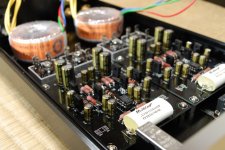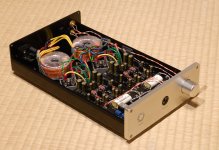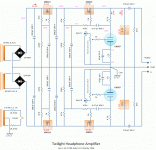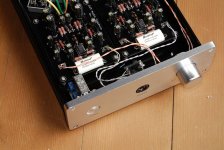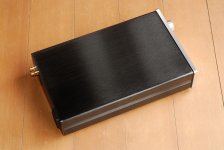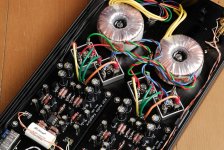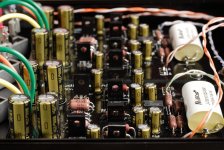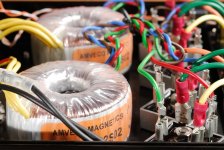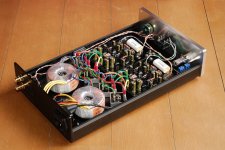Replaced components on my boards yet again.
R7=2.1k, R14=1R
And finished the drill work. Everything in place, just the chassis wiring left to do now.
edit: also finalized the BOM for the next board revision, 12f. These are the final values, barring very small changes and bug fixes.
R7=2.1k, R14=1R
And finished the drill work. Everything in place, just the chassis wiring left to do now.
edit: also finalized the BOM for the next board revision, 12f. These are the final values, barring very small changes and bug fixes.
Attachments
Last edited:
And - it works!
There is no hum or noise unless the volume control is turned up all the way, and not much even then. The sound is clear, clean, extended in both the high and low frequencies. It seems to be working as designed in other words, no obvious faults.
Some quick evaluation this evening only proved it gave out what it was given, into both 16 and 300 ohm loads. Critical analysis will have to wait until later.
There is no hum or noise unless the volume control is turned up all the way, and not much even then. The sound is clear, clean, extended in both the high and low frequencies. It seems to be working as designed in other words, no obvious faults.
Some quick evaluation this evening only proved it gave out what it was given, into both 16 and 300 ohm loads. Critical analysis will have to wait until later.
The Review
This will be done as a comparison study between the Sapphire and Twilight headphone amplifiers.
Source is my Onkyo SE-200PCI sound card and the headphones were the 300 ohm Sennheiser HD-600.
The Twilight is single-ended, a triode-mosfet hybrid mu-follower with about 38 mA bias. The Sapphire, due to a couple of issues with the prototype build, ended up rather less, at 9 mA output bias. Sapphire is op amp voltage stage plus bipolar emitter follower push-pull current buffer.
The characteristics of each amplifier are pretty much what anyone familiar with the circuits would expect:
Twilight is basically the SET sound: warm, intimate, plummy, a little soft, but with enough grunt supplied by the mosfets to control the HD600s effectively and give good dynamics. The soundstage is narrower and more central than the Sapphire. It tends to shine for small scale vocal and acoustic music, and will paper over less-than-stellar recordings to a considerable extent. On the other hand large scale orchestral and heavy rock and pop can sound blurry and indistinct, falling apart on complex passages.
Sapphire is basically the high end solid-state sound: massive, wraparound soundstage, endless reserves of power, intense, gripping dynamics and realistic, precise transients. Black backgrounds, resolution on demand. The bigger and badder the music, the more it shines. To paint that as a negative, the coolness and precision can make acoustic music seem thin, and it will pull no punches in revealing an awful sounding CD for what it is.
While both have advantages and disadvantages, right now I favor the Sapphire and I think it is overall the better of the two amplifiers. I intended it as a homage of sorts to the big high-end solid-state amps of the 1980's and 1990's, and I got much more of that sitting-in-the-audio-demo-room-listening-to-systems-I-cannot-afford feel in the Sapphire than I ever imagined possible in a headphone/headphone amp combination. It's really that good.
RJM
April 2011
This will be done as a comparison study between the Sapphire and Twilight headphone amplifiers.
Source is my Onkyo SE-200PCI sound card and the headphones were the 300 ohm Sennheiser HD-600.
The Twilight is single-ended, a triode-mosfet hybrid mu-follower with about 38 mA bias. The Sapphire, due to a couple of issues with the prototype build, ended up rather less, at 9 mA output bias. Sapphire is op amp voltage stage plus bipolar emitter follower push-pull current buffer.
The characteristics of each amplifier are pretty much what anyone familiar with the circuits would expect:
Twilight is basically the SET sound: warm, intimate, plummy, a little soft, but with enough grunt supplied by the mosfets to control the HD600s effectively and give good dynamics. The soundstage is narrower and more central than the Sapphire. It tends to shine for small scale vocal and acoustic music, and will paper over less-than-stellar recordings to a considerable extent. On the other hand large scale orchestral and heavy rock and pop can sound blurry and indistinct, falling apart on complex passages.
Sapphire is basically the high end solid-state sound: massive, wraparound soundstage, endless reserves of power, intense, gripping dynamics and realistic, precise transients. Black backgrounds, resolution on demand. The bigger and badder the music, the more it shines. To paint that as a negative, the coolness and precision can make acoustic music seem thin, and it will pull no punches in revealing an awful sounding CD for what it is.
While both have advantages and disadvantages, right now I favor the Sapphire and I think it is overall the better of the two amplifiers. I intended it as a homage of sorts to the big high-end solid-state amps of the 1980's and 1990's, and I got much more of that sitting-in-the-audio-demo-room-listening-to-systems-I-cannot-afford feel in the Sapphire than I ever imagined possible in a headphone/headphone amp combination. It's really that good.
RJM
April 2011
Last edited:
I can't wait until I can upload pictures here, I want to share a layout with some modifications I did to the xreg, if that is ok with you, it uses a hybrid of SMT and through hole components. Useing realy top notch SMT caps it costs about $25 dollars in parts includeing the OPA2211 dual opamp and 4 x 0.05% resistors for the 4 input pins. Also added is a fuse on the output rail to be set according to what your heatsinks can handle, so its more to protect the PSU against naughty loads.
I intend to match it with a 6x6cm encased PCB mount torroid transformer, but I'm still scratching my head as to orientation, as I want the transistors to be able to connect to a rear enclosure panel, withou the transformer in the way. Also still need to design the rectifier section, I'm thinking 8x MUR820....
I actualy only scratched out my 4 year old VSPS (opa2228) and its transformer last weekend (a bulky 50VA EI jobbie), after repairing the speed control on my old turntable. Then I ended up makeing a new PCB, (my first version was hand drawn with a magic marker and then etched). I forgot about the DC offset thing, I don't remember my old version haveing such a big one... anyway it works nicely, but I hear a slight distortion at higher frequencies. I think I'll start by removeing the DC blocking caps as I have large input caps on the ampliefier....if that sounnds ok to you.
I intend to match it with a 6x6cm encased PCB mount torroid transformer, but I'm still scratching my head as to orientation, as I want the transistors to be able to connect to a rear enclosure panel, withou the transformer in the way. Also still need to design the rectifier section, I'm thinking 8x MUR820....
I actualy only scratched out my 4 year old VSPS (opa2228) and its transformer last weekend (a bulky 50VA EI jobbie), after repairing the speed control on my old turntable. Then I ended up makeing a new PCB, (my first version was hand drawn with a magic marker and then etched). I forgot about the DC offset thing, I don't remember my old version haveing such a big one... anyway it works nicely, but I hear a slight distortion at higher frequencies. I think I'll start by removeing the DC blocking caps as I have large input caps on the ampliefier....if that sounnds ok to you.
Could you post the Twilight schematic please?
See below.
digits: by all means show us your work
Xreg stuff can maybe posted in a new thread, or appended to the original Phonoclone 3 thread.
Attachments
Thank you rjm. Very nice amp. Are those FETs still available in Japan?
As far as I know, Onkyo sound cards are pretty unknown in Europe.
As far as I know, Onkyo sound cards are pretty unknown in Europe.
Yes, Toshiba SK213 series are still stocked, or they were a couple of years back.
The Onkyo sound cards are domestic only, not sold outside of Japan.
The Onkyo sound cards are domestic only, not sold outside of Japan.
Hitachi. My bad.
And yes, the store is still selling them: http://eleshop.jp/shop/g/g46F13S/ and http://eleshop.jp/shop/c/c11111713/
And yes, the store is still selling them: http://eleshop.jp/shop/g/g46F13S/ and http://eleshop.jp/shop/c/c11111713/
Sapphire Headphone Amplifier Photos
My version revision 10b boards:
hlly case
2x Talema 25VA 12VAC transformers
4x Comchip 50A 1kV bridge rectifiers
20 kohm stepped attenuator (SMT resistors)
(photo notes: Nikon D200, SB-800, micro-Nikkor 55mm F3.5 Ai)
My version revision 10b boards:
hlly case
2x Talema 25VA 12VAC transformers
4x Comchip 50A 1kV bridge rectifiers
20 kohm stepped attenuator (SMT resistors)
(photo notes: Nikon D200, SB-800, micro-Nikkor 55mm F3.5 Ai)
Attachments
Last edited:
Two more photos, at higher resolution.
Regarding the ground connections, the COM of the two channels joins at the shared return tab of the headphone socket, which also has a short third connection to the case. The IEC power socket earth tab is connected to case with a short wire.
Regarding the ground connections, the COM of the two channels joins at the shared return tab of the headphone socket, which also has a short third connection to the case. The IEC power socket earth tab is connected to case with a short wire.
Attachments
Last edited:
Now I regret what I said. Anyway, in my view, 6DJ8 biased at considerably higher current would have been a better choice in this low voltage application.
A fair comment. I used the 6CG7 because I happen to like it, sentimental value you could say. My first tube amp was an RCA console with 6CG7 as input and driver. I borrowed the tube and the operating point from the old RCA circuit. In principle the tube sees a very high load impedance, so bias current does not have to be high, but I agree that for the low voltage application I could have increased it a little to some benefit.
I you were to ask me how I would improve the Twilight, I would suggest instead to ditch the mu-follower configuration entirely: use the triode as the input, with a plate resistor or mosfet CCS as you please, into a coupling capacitor, into a MOSFET source follower, or, thinking one step further, the diamond buffer of the Sapphire. The main complication is you now need two power supplies: the high voltage B+ and the high current rails for the output stage.
/R
I you were to ask me how I would improve the Twilight, I would suggest instead to ditch the mu-follower configuration entirely: use the triode as the input, with a plate resistor or mosfet CCS as you please, into a coupling capacitor, into a MOSFET source follower, or, thinking one step further, the diamond buffer of the Sapphire. The main complication is you now need two power supplies: the high voltage B+ and the high current rails for the output stage.
/R
Got my boards in!! I should be able to order the parts in a few days. I can't wait to get this built!!
Glad to hear that, and I hope the BOM I sent is reasonably clear. If you have any questions just ask.
By the way I have two sets of rev. 10b boards left if anyone else is interested in trying it out. It's very unlikely that I'll have rev 12 boards anytime soon, and the original boards work just fine.
By the way I have two sets of rev. 10b boards left if anyone else is interested in trying it out. It's very unlikely that I'll have rev 12 boards anytime soon, and the original boards work just fine.
- Status
- Not open for further replies.
- Home
- Amplifiers
- Solid State
- Headphone amplifier drop-in replacement for Phonoclone 3 and VSPS300
